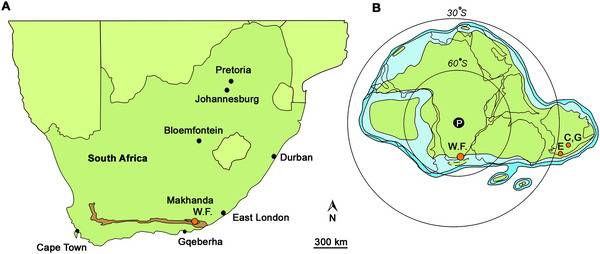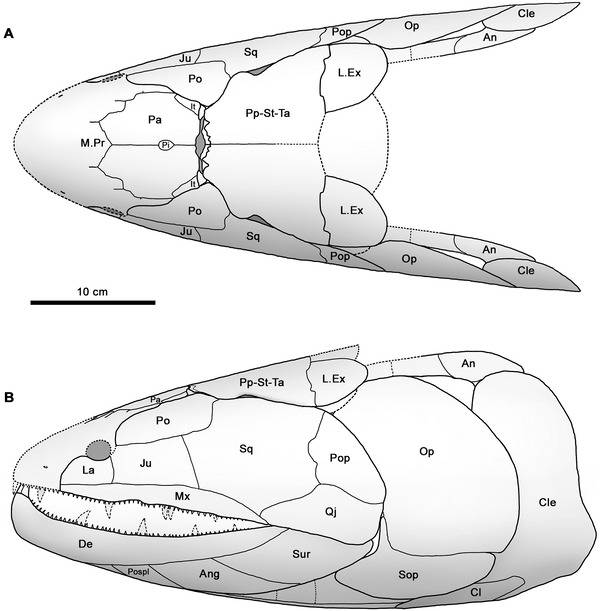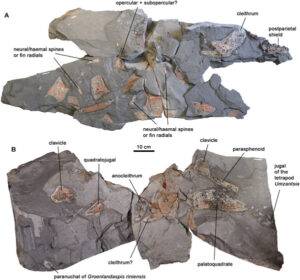Fossil remains have always offered great light to the unknown. They help historians and laymen conclude the extinction of certain species and make policies relevant. Moving on, in recent times, researchers have come across the fossils of giant ancient fish, which probably dominated the Earth’s surface 360 years ago.
The place of excavation is a cutting outside Waterloo Farm close to Makhanda/Grahamstown (South Africa). And researchers have taken the fossil to the Albany Museum in the same city. This discovery has offered a unique window to the unknown phases from the later time of the Devonian world.
Materials and methods in the study – Fossils of giant ancient fish
Before the dinosaurs dominated the planet, the Earth used to be a living place for gigantic fishes combining deadly fangs. These particulars are the latest of their tribe to be discovered, and researchers have named them “Hyneria udlezinye,” or the one who can consume the other animals. Because of the fragile nature of the same and the bones being diagenetically altered, the researchers chose manual labor. And no power tools were used.

Here is a list of points elaborating on the prerequisites of the study:
- The specimens underwent manual preparation without the use of power tools.
- Later, photographs were taken of the bones eliminating any form of coating.
- The researchers went forward seeking interpretative drawings from the photographs themselves.
- Now, a three-dimensional reconstruction of the skull was made possible by combining paper outlines and creating a three-dimensional model.
- Researchers with the developmental team did trace all of it down in Adobe Photoshop.
- Thought research and excavation works like these require permits from the authorities. However, that was not essential in this case because the first author is an employee of the Albany Museum. And the first author did invite the second author to collaborate.
Fossils of giant ancient fish – The findings
Both the researchers and the others from the University of Rhodes in South Africa have come to the conclusion that the fish might have been somewhat in between 180-190 cm in length.

The findings include the fish’s
- Skull roof
- Cheek
- Lower jaw
- Palate
- Operculogular series
- Pectoral girdle
- Ulnare
- Axial skeleton
- Lepidotrichia and Squamation
Also, the research team has come to terms with the fact that the bone findings of Hyneria udlezinye are quite in common with that of Hyneria lindae. And they will be conducting appropriate research and comparison of the two. Also, feature comparisons will be made with other tristichopterids fossils in the later part of the research.
Fossils of giant ancient fish – Research Discussions
- The research team has identified the Hyneria udlezinye fossil belonging to the giant tristichopterid version. That is because the characteristics of the bones detected are similar to that of the latter one discussed.
- Also, the team got to assume the body proportions correctly by finding similarities with Mandageria – one of the largest tristichopterids found to date.
- Though finding adequate information about a freshly detected fossil is difficult, thorough research and analysis make it possible.
The fossil of giant ancient fish getting termed as Hyneria – Reasons
- The Waterloo farm’s discovery has a small postpineal region.
- Also, the scale morphology and ornament are characterized by a deeply folded margin across the trailing edge.
- The specimen is different from that of H. Lindae in terms of lacrimal & prearticular proportions. Also, the maxilla morphology of the same is much close to the features offered by the Tristichopteridae.
- Finally, the giant fish used to have dentary fangs. Which did remain constant for the entire living and evolutionary span of the same.
Further findings about Hyneria udlezinye
- The fish did possess an enlarged branchial chamber. But due to the fragile condition of the bones found, it gets difficult to reconstruct an entire structure out of the same.
- It has similar gill covers to the Hyneria lindae but with deeper levels of subopercular.
- Also, the Hyneria udlezinye fossils’ excavation sheds light on the unknown world of the late tristichopterids.
- Unknown facts about the late Devonian era are also coming to the surface. As per records, the tristichopterids have a global distribution level and are equally spread over the Famennian. So far, various Famennian species have been discovered in different parts of the world. Now, with the discovery of Hyneria udlezinye in the regions of South Africa and Pennsylvania, scientists got to find possible interconnections among the Famennian world.

- However, this time it is on a more specific level, helping researchers know the exact location of the place where the giants originated.
- Researchers did conclude the origin of the Hyneria udlezinye within the Australian radiation.
- Finally, the discovery of the Hyneria udlezinye helps with the fact that Hyneria has trails from the Gondowana distribution. In fact, the geographical location of the Waterloo farm suggests the same, having been widely distributed across the Gondwana region.
Final Findings
Hyneria udlezinye, with a length of almost three meters, turns out to be the largest the vertebrate specimen and osteichthyan in Waterloo Farm. Because of the degenerating specimen outputs, it was not easy to develop a complete structure of the particular. And the research team had to indulge in a lot of manual labor. However, close comparison and the detailed study did make the Hyneria udlezinye stand out from the Hyneria lindae. These effects were minor and related mainly to the body parts of the lower jaw, skull roof, cheek, and operculum.
Moving on, the Hyneria udlezinye did offer close consistency with that of the giant tristichopterids. Thus representing the Gondwanan radiation. Also, this particular kind is the first of its kind, which underwent records from a high palaeolatitude. While others so far did belong to the mid-palaeolatitude and palaeoequatorial localities. Overall, the excavation study did offer adequate details for the researchers to vouch for and also get to know about the unknown that was not possible so far.



